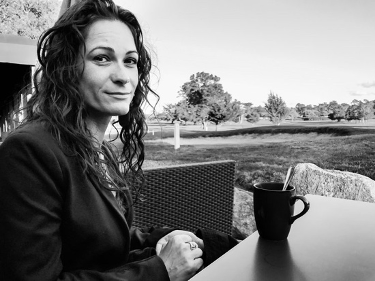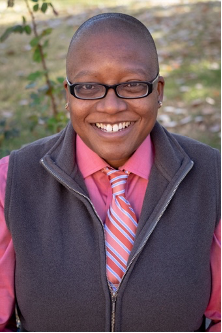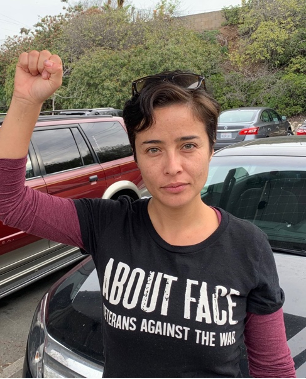When she joined Veterans For Peace in 2015 it didn’t take Army veteran Monisha Ríos long to learn that there is a status hierarchy among vets—even those working for peace and justice. On meeting Ríos, VFP members would ask if she was a combat vet, and Ríos knew immediately that when she said no, “They’re not gonna take me seriously, I’m not gonna matter. I won’t be considered important. To the work of peace. As a veteran.” But it didn’t take her long to settle on her answer to that question: “I say, ‘I was in unconventional combat. As in, every fucking day, I had to fight to not get raped. As a woman in the military. So, yeah. I was in combat.’”
In my book Unconventional Combat: Intersectional Action in the Veteran’s Peace Movement, I chronicle the experiences and political strategies of Monisha Ríos and other “post 9/11 veterans”—most of them women and BIPOC people, some who identify as queer or gender non-binary. I analyze the promise and pitfalls facing this young and diverse generation of veterans as they claim positions of centrality in a veterans’ peace movement that, until recently, has been dominated by older veterans, mostly white men from the Vietnam War era.
It shouldn’t surprise us that more women, BIPOC, queer and transgender veterans are joining organizations like Veterans For Peace or About Face: Veterans Against the War. Though the military is still dominated by men, women have increased in number, and expanded the scope of their participation in recent decades. In 1973, when military conscription ended, women made up a scant 2% of active duty members of the military. Today, women constitute 16% of U.S. military active duty and 18% of reserve personnel. And women’s growing numbers have further diversified the military in other ways: proportionately, women service members are even more diverse than their male counterparts: Roughly one-third of women service members are Black, and more than half (56%) identify as a racial minority and/or as ethnically Hispanic.
Since President Barack Obama in 2013 lifted the ban on women serving in combat roles, growing numbers of women have served in central battle zones of Iraq and Afghanistan, absorbing an escalating share of physical and psychological injuries. An appalling proportion of the injury and trauma suffered by military women is delivered not by foreign combatants, but by men from their own ranks. Recent research by sociologist Stephanie Bonnes concludes that “More than half of the women serving in the U.S. military have experienced workplace sexual harassment, with some estimates as high as 79%.” A comprehensive study commissioned by the U.S. Marine Corps to answer the question, “What it is like to be both a woman and a Marine,” painted a picture of endemic sexual assault, hostile work environments, online sexual harassment, and officers who perceive women as weak and undeserving of being in the Corps. Stalking experiences during military service, Carrie L. Lewis and her colleagues found, commonly causes PTSD and depression. As a result, over half a million U.S. women veterans have enrolled in the Veterans Administration (VA) health care system, many of them seeking support for what Suzanne Gordon has called the “vexing problem” of military sexual trauma (MST).
As a racially diverse cohort of women soldiers has grown in recent decades, so too has the visibility of LGBTQ+ people in the service. Most of the U.S. Military’s history is a story of compulsory heterosexuality coupled with institutional denials or violent suppression of same-sex desire and actions. But the “coming out” ethos of the gay and lesbian liberation movement of the 1970s was echoed in calls to eliminate the military’s anti-gay policies. Prominent members of the military brass stiffly opposed including gay and lesbian people in the service. In what Randy Shilts called a “…last great frenzy of antigay hostility,” the U.S. military by the start of the 1990s had accelerated its rate of soldiers being drummed out of the service for homosexuality.
In 1994, the Clinton Administration instituted “Don’t Ask, Don’t Tell” (DADT), which became the official policy governing gay, lesbian and bisexual people in the military until its repeal in 2011. Billed as a compromise at the time, DADT barred the military from punishing or discharging someone who was closeted, but it allowed the discharge of individuals who openly stated they were gay or lesbian, or who were seen or known to have engaged in same-sex relationships. DADT ultimately reinforced the boundaries of an oppressive “camouflage closet” for LGBTQ+ service members like Zamil Salhab, whose story I tell in the book. Salhab, who identifies as a queer non-binary person of color, suffered from the marginalization and violence of gendered racism and homophobia while serving ten years in the military, including two combat deployments in Iraq.
The 2011 elimination of DATD created legal inclusion for LGBTQ+ people in the U.S. military. However, scholars Brandon Alford and Shawna Lee argue that this greater statutory inclusion “…does not address a number of cultural or institutional inequities that continue to hinder full inclusion of sexual minority service members.”
As I show in Unconventional Combat, hostility to non-heterosexual people in the military, especially when combined with gendered racism, continues to create toxic and punishing experiences for women, BIPOC and LGBTQ+ service members. Following their military careers, as veterans like Monisha Ríos and Zamil Salhab join the veterans’ peace movement, their experiences of MST, gendered racism, homophobia and transphobia shape a shared situated knowledge of interlocking oppressions. This collective knowledge, I argue, is the foundation for an intersectional praxis that presses for change on two wide fronts: First, challenging the race, gender and sexual business-as-usual inside progressive organizations like Veterans For Peace; second, forging new strategies for linking veterans’ anti-militarism with movements for racial justice, climate action, and ending gender and sexual violence. “We can’t use the same linear thinking,” Army combat veteran Wendy Barranco told me. “You’ve got to do something radical. And something radical is like, let women lead, period.”
________________________________
Michael A. Messner is professor of sociology and gender studies at the University of Southern California.



